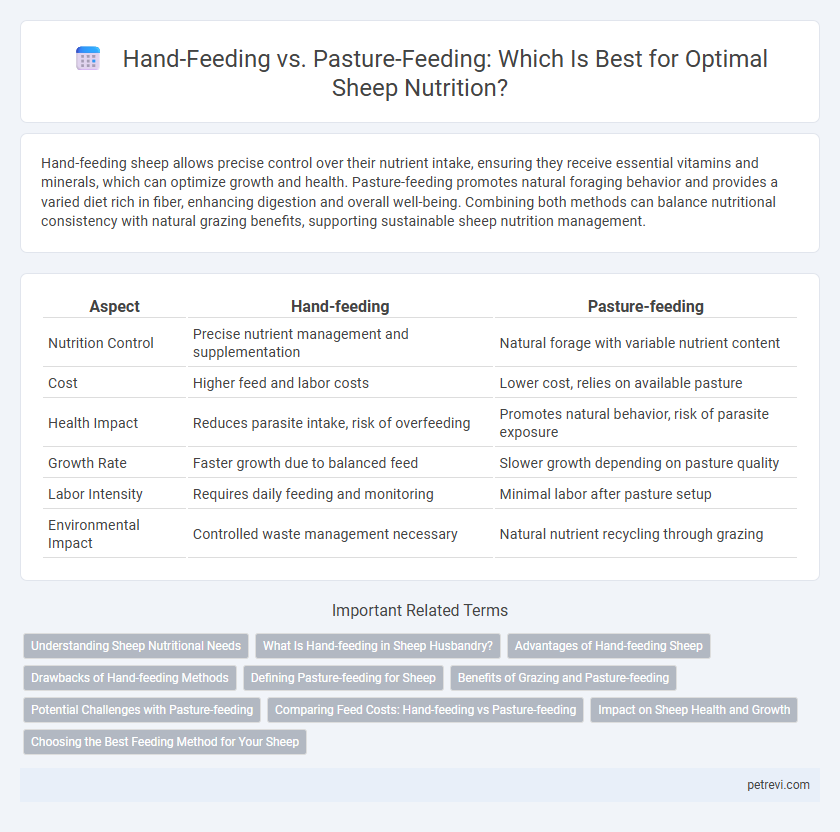Hand-feeding sheep allows precise control over their nutrient intake, ensuring they receive essential vitamins and minerals, which can optimize growth and health. Pasture-feeding promotes natural foraging behavior and provides a varied diet rich in fiber, enhancing digestion and overall well-being. Combining both methods can balance nutritional consistency with natural grazing benefits, supporting sustainable sheep nutrition management.
Table of Comparison
| Aspect | Hand-feeding | Pasture-feeding |
|---|---|---|
| Nutrition Control | Precise nutrient management and supplementation | Natural forage with variable nutrient content |
| Cost | Higher feed and labor costs | Lower cost, relies on available pasture |
| Health Impact | Reduces parasite intake, risk of overfeeding | Promotes natural behavior, risk of parasite exposure |
| Growth Rate | Faster growth due to balanced feed | Slower growth depending on pasture quality |
| Labor Intensity | Requires daily feeding and monitoring | Minimal labor after pasture setup |
| Environmental Impact | Controlled waste management necessary | Natural nutrient recycling through grazing |
Understanding Sheep Nutritional Needs
Sheep require a balanced intake of protein, energy, vitamins, and minerals to maintain optimal health and productivity. Hand-feeding allows precise control over nutrient intake, ensuring deficiencies are prevented, especially during pregnancy or lactation. Pasture-feeding provides diverse forage rich in fiber and essential nutrients but may vary in quality seasonally, necessitating supplementation for consistent nutrition.
What Is Hand-feeding in Sheep Husbandry?
Hand-feeding in sheep husbandry involves providing precise amounts of supplemental feed directly to sheep, ensuring controlled nutrient intake essential for growth, reproduction, and health maintenance. This method allows farmers to monitor individual consumption, prevent nutrient deficiencies, and tailor diets during critical periods such as pregnancy or lactation. Hand-feeding is particularly beneficial in environments where pasture quality is poor or seasonal variations limit natural forage availability.
Advantages of Hand-feeding Sheep
Hand-feeding sheep allows precise control over nutrient intake, ensuring balanced diets tailored to individual needs, which supports optimal growth and health. This method reduces competition among animals, minimizing stress and preventing weaker sheep from being underfed. Targeted supplementation through hand-feeding enhances immune function and productivity by providing essential vitamins and minerals not always available in pasture grazing.
Drawbacks of Hand-feeding Methods
Hand-feeding sheep often leads to inconsistent nutrient intake and increased labor costs, which can negatively impact flock health. This method frequently results in uneven weight gain and digestive issues due to irregular feeding schedules. Furthermore, hand-feeding limits natural foraging behavior, reducing overall animal welfare and increasing stress levels.
Defining Pasture-feeding for Sheep
Pasture-feeding for sheep involves grazing on natural or cultivated grasses, legumes, and herbs, providing a diverse and nutritionally balanced diet rich in fiber, vitamins, and minerals. This feeding method promotes rumen health, optimal digestion, and natural foraging behaviors, contributing to improved wool quality and growth rates. Pasture diversity and seasonal variability can influence nutrient availability, requiring careful pasture management to maintain consistent sheep nutrition.
Benefits of Grazing and Pasture-feeding
Grazing on diverse pastures provides sheep with a natural, nutrient-rich diet high in fiber, vitamins, and minerals essential for optimal health and wool quality. Pasture-feeding promotes rumen function and microbial diversity, enhancing digestion and reducing the risk of metabolic disorders compared to hand-feeding. Access to fresh forage also encourages natural foraging behavior, improving animal welfare and resilience against parasitic infections.
Potential Challenges with Pasture-feeding
Pasture-feeding sheep can present challenges such as variable nutrient availability influenced by pasture quality, seasonal changes, and climate conditions, leading to inconsistent weight gain and health issues. Parasite infestations and toxic plant ingestion are significant risks inherent in unmanaged grazing systems, impacting overall flock productivity. Effective pasture management and supplemental feeding strategies are crucial to mitigate these challenges and ensure balanced nutrition for optimal sheep growth and reproduction.
Comparing Feed Costs: Hand-feeding vs Pasture-feeding
Hand-feeding sheep involves higher direct feed costs due to purchased grains, hay, and supplements, often exceeding $0.30 per sheep per day, while pasture-feeding minimizes expenses by utilizing natural forage with costs as low as $0.05 per sheep per day. Pasture quality, stocking density, and seasonal availability strongly influence the nutritional value and cost-effectiveness of grazing, whereas hand-feeding offers precise nutrient control but increases labor and input expenses. Sustainable pasture management can optimize feed intake and reduce reliance on costly concentrates, improving overall economic efficiency in sheep nutrition systems.
Impact on Sheep Health and Growth
Hand-feeding sheep allows precise control over nutrient intake, supporting optimal growth rates and preventing deficiencies, while pasture-feeding offers natural foraging behavior and diverse nutrients that enhance gut health and immune function. Sheep on carefully managed pasture typically exhibit improved rumen development and lower incidence of digestive disorders compared to exclusively hand-fed animals. Balancing both methods can maximize sheep health by combining nutrient accuracy with the benefits of natural grazing.
Choosing the Best Feeding Method for Your Sheep
Hand-feeding sheep allows precise control over nutrient intake, essential for addressing specific health needs and optimizing growth rates with supplements like grains and minerals. Pasture-feeding supports natural foraging behavior, promoting digestive health and reducing feed costs while providing diverse plant nutrients and fiber. Selecting the best feeding method depends on factors such as flock size, pasture quality, and individual animal requirements, balancing nutrition efficiency and management practicality.
Hand-feeding vs Pasture-feeding for Sheep Nutrition Infographic

 petrevi.com
petrevi.com